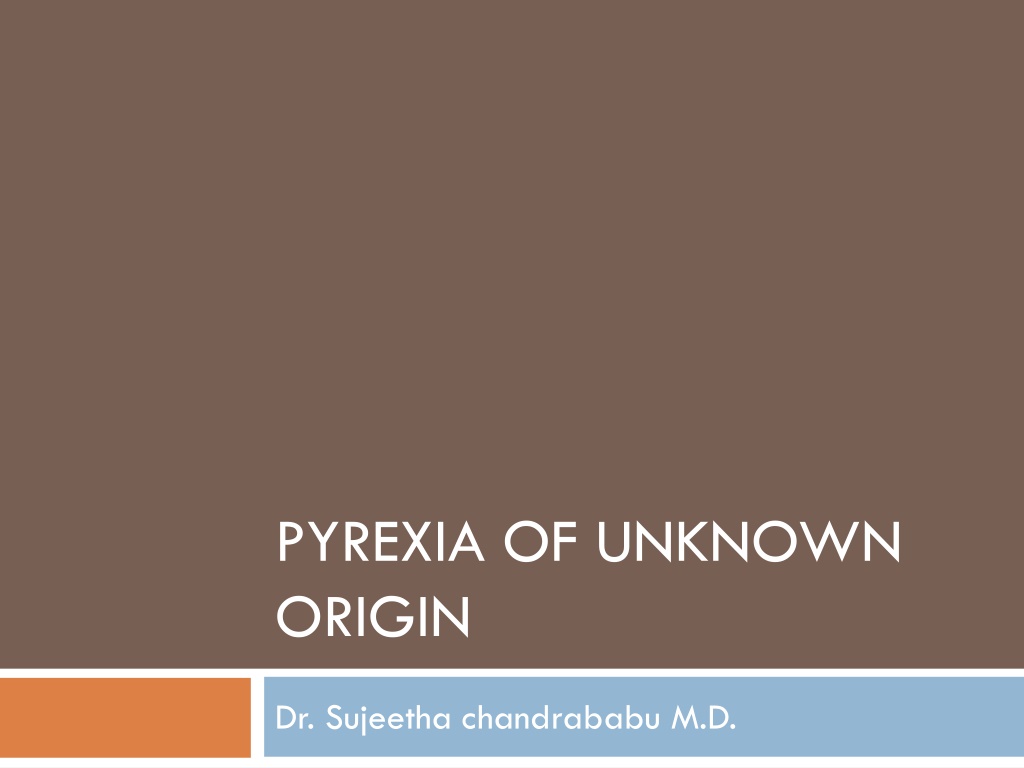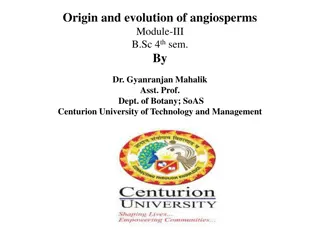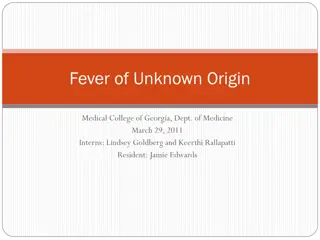Understanding Pyrexia of Unknown Origin: Causes and Classification
Pyrexia of unknown origin (PUO) is a challenging diagnostic scenario characterized by persistent fever without an identified cause. Dr. Sujeetha Chandrababu M.D. defined PUO as temperatures exceeding 38.3°C for several weeks with no definitive diagnosis. Classification of PUO includes various categories based on etiologies such as infection, malignancy, collagen vascular disease, immunodeficiency, and more. Common causes of PUO include infections, autoimmune diseases, malignancies, and miscellaneous reasons. In India, infectious diseases, tuberculosis, neoplasms, and rheumatic conditions are prevalent causes of fever of unknown origin. The classic etiologies of PUO are infections, malignancies, and collagen vascular diseases. Infections can be bacterial, parasitic, fungal, or viral in nature, leading to conditions like abscesses, TB, endocarditis, malaria, CMV, and more.
Download Presentation

Please find below an Image/Link to download the presentation.
The content on the website is provided AS IS for your information and personal use only. It may not be sold, licensed, or shared on other websites without obtaining consent from the author. Download presentation by click this link. If you encounter any issues during the download, it is possible that the publisher has removed the file from their server.
E N D
Presentation Transcript
PYREXIA OF UNKNOWN ORIGIN Dr. Sujeetha chandrababu M.D.
Original Definition (by Petersdorf and Beeson, 1961) Temperatures 38.3 C (101 F) on several occasions Fever 3 weeks Failure to reach a diagnosis despite 1 week of inpatient investigations or 3 outpatient visits [1 IP / 3 OP]
Classification of PUO Category Definition Aetiologies Classic Temperature >38.3 C (100.9 F) ; Duration of >3 weeks Evaluation of at least 3 outpatient visits or 3 days in hospital Infection Malignancy collagen vascular disease Nosocomial Temperature >38.3 C Patient hospitalized 24 hours but no fever or incubating on admission Evaluation of at least 3 days Clostridium difficile enterocolitis drug-induced pulmonary embolism septic thrombophlebitis, sinusitis Immune deficient (neutropenic) Temperature >38.3 C Neutrophil count 500 per mm3 Evaluation of at least 3 days Opportunistic bacterial infections, aspergillosis, candidiasis, herpes virus HIV- associated Temperature >38.3 C Duration of >4 weeks for outpatients, >3 days for inpatients HIV infection confirmed Cytomegalovirus, Mycobacterium avium-intracellulare complex, Pneumocystis carinii pneumonia, drug-induced, Kaposi s sarcoma, lymphoma
COMMON CAUSES OF PUO Undiagnosed (10%) Others/ Miscellaneous (10%) Infection (40%) Autoimmune Disease (15%) Malignancy (25%)
Causes of FUO (in India) Infectious 53% Unknown 14% TB 24% #1: TB (45%) Misc. 5% Neoplasm: 17% Other Rheum 6% #1: NHL (47%) Collagen Vasc.: 11% SLE 5% Abscess 7% #1 SLE: 45% Endocarditis 5% Other Onc 9% Miscellaneous: 5% Undiagnosed: 14% NHL 8% Other ID 17% Kejariwal D et al. J Postgrad Med. 2001 Apr-Jun; 47(2): 104-7.
Classic PUO 3 common etiologies which account for the majority of classic PUO: Infections Malignancies Collagen Vascular Disease Others/Miscellaneous which includes drug- induced fever.
Infections Bacterial: abscesses, TB, complicated UTI, endocarditis, osteomyelitis, sinusitis, Lyme disease, prostatitis, cholecystitis, empyema, bill- ary tract infection, brucellosis, typhoid, leptospirosis, Q fever, borreliosis, etc. Parasite: Malaria, toxoplamosis, leishmaniasis, etc. Fungal: histoplasmosis, etc. Viral: CMV, infectious mononucleosis, HIV, etc.
Infections As duration of fever increases, infectious etiology decreases Malignancy and factitious fevers are more common in patients with prolonged FUO.
Malignancies Haematological Lymphoma Chronic leukemia Non-haematological Renal cell cancer Hepatocellular carcinoma Pancreatic cancer Colon cancer Hepatoma Myelodysplastic Syndrome Sarcomas
Collagen vascular disease / Autoimmune disease Adult Still's disease Polyarteritis nodosa Giant cell arteritis Kawasaki disease Still s disease Polymyalgia rheumatica Temporal arteritis Rheumatoid arthritis Rheumatoid fever Inflammatory bowel disease Reiter's syndrome Systemic lupus erythematosus Vasculitides
Others/miscellaneous Drugs: penicillin, phenytoin, captopril, allopurinol, erythromycin, cimetidine, etc. Hyperthyroidism Alcoholic hepatitis Sarcoidosis Inflammatory bowel disease Deep Venous Thrombosis
Roth AR and Basello GM. Am Fam Physician. 2003 Dec 1;68(11):2223-8.
Nosocomial PUO More than 50% of patients with nosocomial PUO are due to infection. Focus on sites where occult infections may be sequestered, such as: - Sinusitis of patients with NG or oro-tracheal tubes. - Prostatic abscess in a man with a urinary catheter. 25% of non-infectious cause includes: - Acalculous cholecystitis, - Deep vein thrombophlebitis - Pulmonary embolism.
Neutropenic PUO Patients on chemotherapy or immune deficiencies are susceptible to: - Opportunistic bacterial infection - Fungal infections such as candidiasis - Bacteremic infections - Infections involving catheters - Perianal infections. Examples of aetiological agent: - aspergillus - Candida - CMV - Herpes simplex
HIV-associated PUO HIV infection alone may be a cause of fever. Common secondary causes include: - Tuberculosis - Toxoplasmosis - CMV infection - P. carinii infection - Salmonellosis - Cryptococcosis - Histoplasmosis - Non-Hodgkin's lymphoma - Drug-induced fever
Pyrexia of Unknown Origin A Clinical Approach
History Taking History of Presenting Illness (HOPI) 1 Onset - acute: Malaria, pyogenic infection - gradual: TB, thyphoid fever 2 Character high grade fever: UTI, TB, malaria, drug 3 Pattern sustained/persistent: Thyphoid fever, drugs
intermittent fever: Daily spikes: Abscess, TB, Schistosomiasis Twice-daily spikes: Leishmaniasis Saddleback fever: Leptospirosis, dengue,borrelia -relapsing/ recurrent fever: Non-falciparum malaria, Brucellosis, Hodgkin s lymphoma 4 Antecedents - prior to onset of fever: dental extraction: Infective endocarditis Urinary catherization: UTI, bacteremia.
5Associated symptoms Chills & rigors bacterial, rickettsial and protozoal disease, influenza, lymphoma, leukaemia, drug-induced Night sweats TB, Hodgkin s lymphoma Loss of weight Malignancy, TB Cough and Dyspnoea Miliary TB, multiple pulmonary emboli, AIDS patient with PCP, CMV. Headache Giant cell arteritis, typhoid fever, sinusitis Joint pain RA, SLE, vasculitis
Abd. Pain Cholangitis, biliary obstruction, perinephric abscess, Crohn s disease, dissecting aneuryms, gynaecological infection Bone pain Osteomyelitis, lymphoma Sorethroat IM, retropharyngeal abscess, post-Streptococcal infection Dysuria, rectal pain Prostatic abscess, UTI Altered bowel habit IBD, thyphoid fever, schistosomiasis, amoebiasis Skin rash Gonococcal infection, PAN NHL, dengue fever
Past Medical History Malignancy = leukemia, lymphoma, hepatocellular ca HIV infection DM IBD collagen vascular disease-SLE, RA, giant cell arteritis TB Heart disease: valvular heart disease Past Surgical History Post splenectomy/ post- transplantation Prosthetic heart valve Catheter, AV fistula Recent surgery/ operation
Drug History Immunosuppressive drug/ corticosteroid Anticoagulants: accumulation of old blood in closed space e.g. retroperitoneal, perisplenic Before fever: drug fever occur within 3 months after starting taking drugs may cause hypersensitivity and low grade fever, usually associated with rash Due to the allergic reaction, direct effect of drug which impair temperature regulation (e.g. phenothiazine) E.g. Antiarrhythmic drug: procainamide, quinidine; Antimicrobacterial agent: penicillin, cephalosporin, hydralazine After fever: may modify clinical pictures, mask certain infection e.g. SBE, antibiotic allergy Family History Anyone in family has similar problem: TB, familial Mediterranian fever
Social History Travel amoebiasis, typhoid fever, malaria, Schistosomiasis Residental area malaria, leptospirosis, brucellosis Occupation farmers, veterinarian, slaughter-house workers = Brucellosis workers in the plastic industries = polymer-fume fever
Contact with domestic / wild animal / birds : Brucellosis, psittacosis (pigeons), Leptospirosis, Q fever, Toxoplasmosis Diet history unpasteurized milk/cheese = Brucellosis poorly cooked pork = Trichinosis IVDU = HIV-AIDS related condition, endocarditis Sexual orientation = HIV, STD, PID Close contact with TB patients
Pyrexia of Unknown Origin Physical Examination
Examination General Pattern of fever (continous, intermittent, relapsing) Ill/not ill Weight loss (chronic illness) Skin rash
Hands Stigmata of Infective Endocarditis Vasculitis changes Clubbing Presence of arthropathy Raynaud s phenomenon
Arms Drug injection sites (ivdu) Epitrochlear and axillary nodes (lymphoma, sarcoidosis, focal infection) Skin
Head & neck Feel temporal arteries (tender & thicken) Eyes iritis/conjuctivitis (ct disease reiter syndrome) Jaundice (ascending cholangitis) Fundi choroidal tubercle (miliary tb), roth s spot (ie) and retinal haemorrhage (leukaemia) Lymphadenopathy
Face & mouth Butterfly rash Mucous membranes Seborrhoic dermatitis (hiv) Mouth ulcers (sle) Buccal candidiasis Teeth & tonsils infection (abscess) Parotid enlargement Ears otitis media
Chest Bony tenderness Cvs murmurs (ie, atrial myxoma), rubs (pericarditis) Resp signs of pneumonia, tb, empyema and lung ca
Abdomen Rose coloured spot (typhoid fever) Hepatomegaly (sbp, hepatic ca, met) Splenomegaly (haemopoietic malignancy, ie, malaria) Renal enlargement (renal cell ca) Testicular enlargement (seminoma) Penis & scrotum discharge/rash Inguinal ligament Per rectal exam mass/tenderness in rectum/pelvis (abscess, ca, prostatitis) Vaginal Examination collection of pelvic pus/ Pelvic Inflammatory Disease
Central Nervous System Signs of meningism (chronic tb meningitis) Focal neurological signs (brain abscess, mononeuritis multiplex in polyarteritis nodosa)
Pyrexia of Unknown Origin Investigation
Stage 1: Laboratory investigations Stage 1: (screening tests) Full blood count ESR & CRP BUN LFTs Blood culture Serum virology Urinalysis and culture Sputum culture and sensitivity Stool ME and occult blood 10. CXR 11. Mantoux test 7. 1. 8. 2. 3. 9. 4. 5. 6.
Stage 2: Laboratory investigations Stage 2: Repeat history and examination Protein electrophoresis CT (chest, abdomen, pelvis) Autoantibody screen (ANA, RF, ANCA, anti- dsDNA) ECG Bone marrow examination Lumbar puncture Consider PSA, CEA Temporal artery biopsy 10. HIV test counselling 6. 1. 7. 2. 8. 3. 9. 4. 5.
Stage 3: Laboratory investigations Stage 3: Echocardiography Further Ix abdomen (Indium-labelled WC scan IBD, abscesses, local sepsis) Barium studies IVU Liver biopsy Exploratory laparotomy Bronchoscopy 6. 1. 2. 7. 3. 4. 5.
Stage 4: Laboratory investigations Treat TB, endocarditis, vasculitis, trial of aspirin/ steroids
Diagnosing Pyrexia of Unknown Origin
Imaging Studies Tuberculosis, malignancy, Pneumocystis carinii pneumonia Chest radiograph CT of abdomen or pelvis with contrast agent Abscess, malignancy Infection, malignancy Gallium 67 scan Occult septicemia Indium-labeled leukocytes Acute infection and inflammation of bones and soft tissue Technetium Tc 99m Malignancy, autoimmune conditions MRI of brain Malignancy, inflammation PET scan Transthoracic or transesophageal echocardiography Bacterial endocarditis Venous thrombosis Venous Doppler study
Diagnosis More invasive testing, such as LP or biopsy of bone marrow, liver, or lymph nodes, should be performed only when clinical suspicion shows that these tests are indicated or when the source of the fever remains unidentified after extensive evaluation. When the definitive diagnosis remains elusive and the complexity of the case increases, an infectious disease, rheumatology, or oncology consultation may be helpful.























